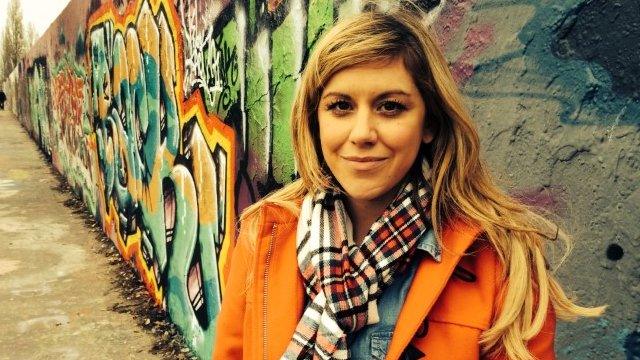What was the Cold War?
- Published
- comments
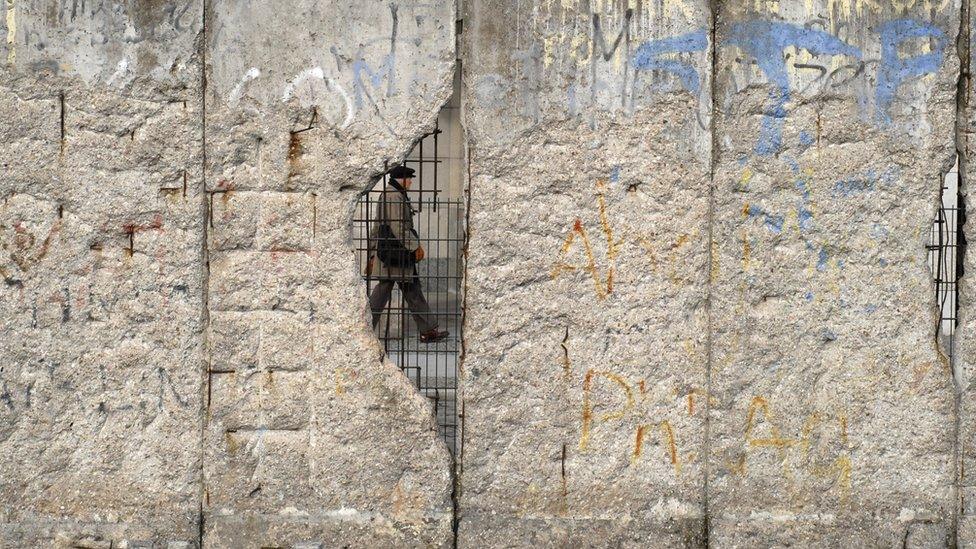
Today marks the 70th anniversary of an important moment in modern history, when Germany was divided into two following the end of World War Two - part of which involved the Berlin Wall being built (seen in this picture)
Today marks the 70th anniversary of an important moment in modern history, when Germany was divided in two, into West and East, following the end of World War Two.
The Federal Republic of Germany (West Germany) was created from areas occupied by the British, French and Americans, while the German Democratic Republic (East Germany) was established from territory occupied by the Soviet Union.
As part of this division, the Berlin Wall was built in 1961 to separate the capital city between the two halves.
East and West Germany existed as separate countries until the fall of the Berlin Wall in November 1989, bringing the country back together.
This division was a significant part of something called the Cold War, which was a 40-year conflict between the east and the west, which came to an end in 1991, just after the Berlin Wall came down.
Read on to find out more about the Cold War and why it was such a significant part of modern history.
What was the Cold War?
The Cold War was a division between Russia and western countries (the US and its allies, like Britain), which started in the 1940s and lasted until 1991.
It is hard to pinpoint an exact date for when it started. It was a war between two ideas and ways of ruling - communism (the east) and capitalism (the west).
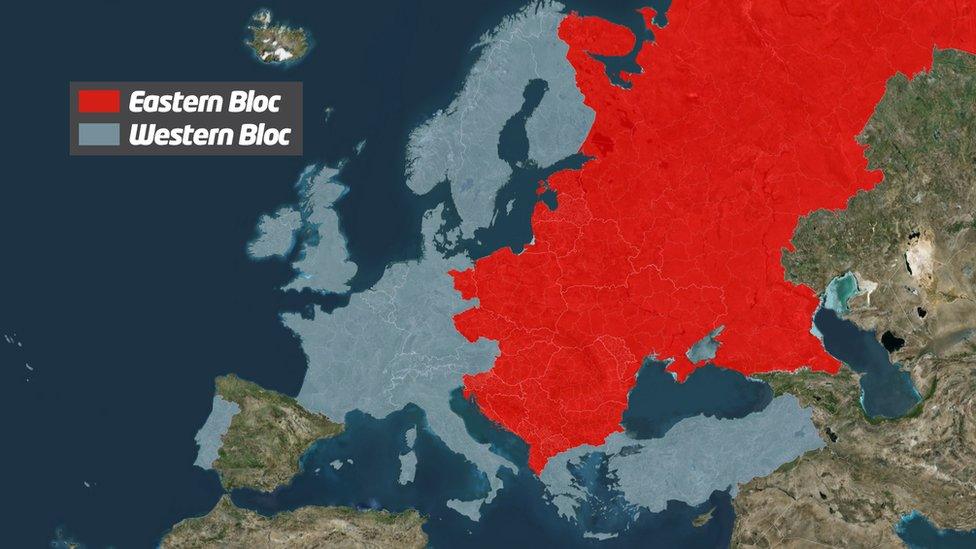
This map shows the west in blue and the east in red, with the US also on the side of the west
The Russians operated a communist state (from 1922 to 1991), while western countries like the US were capitalist countries.
Throughout the Cold War, communist and capitalist nations tried to out-do each other, competing to develop the best technologies and weapons.
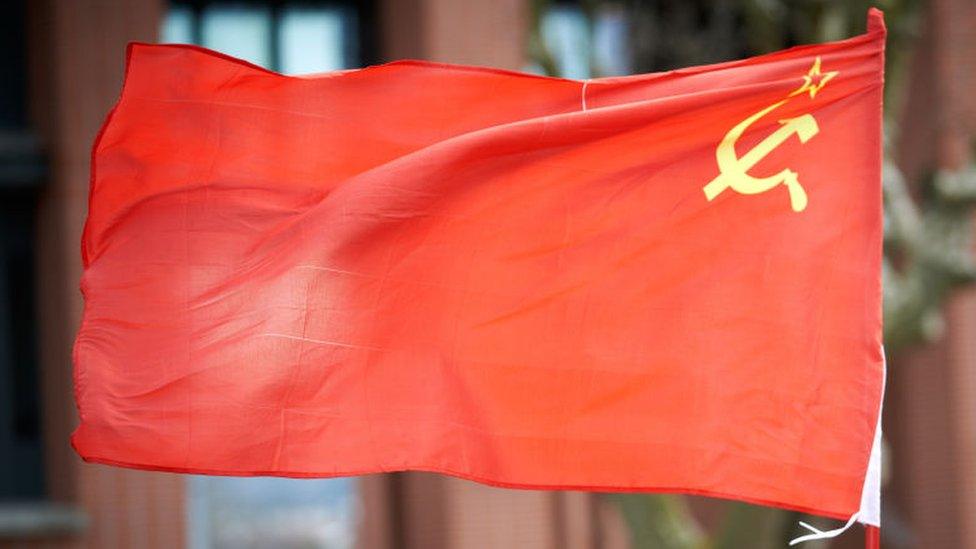
The flag of the communist power in the Cold War was a red flag with a gold hammer crossed with a sickle, which is a symbol of communism
What is capitalism?
In a capitalist system:
Citizens are allowed to have their own businesses and make their own money
It revolves around something called free markets, in which companies and business people can buy and sell products and services, depending on what customers and the public want (which also determines how much things will cost), with little or no government control
Usually, there are multiple political parties that stand for different parts of society (but this doesn't always have to be the case in a capitalist society)
Governments are chosen in democratic elections, in which citizens have their say on who they want to be in charge (a democracy)
People's rights and freedoms are an important part of life, including being able to say what they feel (freedom of speech)
The press enjoys freedom of speech too and is not controlled by the state
What is communism?
In a communist system:
Businesses are owned by the state and any wealth from them is controlled by the people in power
There is one political party in charge
There is no opportunity for citizens to vote for who they want to be in charge or change the government (a dictatorship)
It is more important to serve the state and be obedient to those in charge than it is to have personal freedoms
The media is controlled by those in power
Where did communism come from?
To understand why the Cold War started, it is necessary to understand where communism in Russia came from, as it was the first time that this system of ruling had been introduced.
In 1917, the Bolsheviks took power in Russia after the October Revolution and a new political system called communism was introduced. (In the years to follow, some other countries including China, North Korea and Cuba would adopt communism too.)
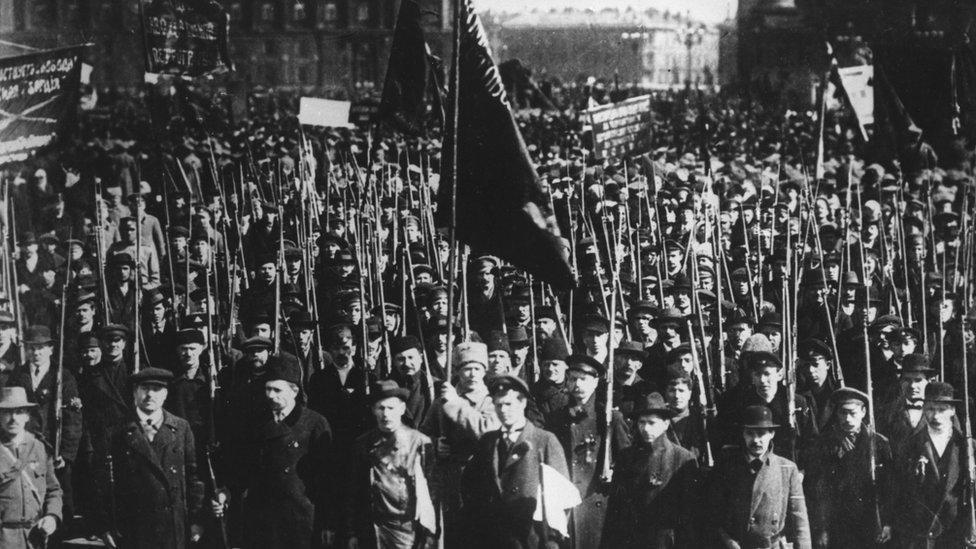
A group of demonstrators gather in Palace Square, Moscow in May 1917
In 1922, Russia - along with countries under its control - formed the Union of Soviet Socialist Republics (the USSR) - better known as the Soviet Union (or the Soviets). It was a communist group and did not agree with western, capitalist countries or their way of ruling.
Why did the Cold War start?
The Cold War started in the aftermath of World War Two, but its foundations came earlier than this.
During World War Two, something unusual happened. After Hitler started to invade USSR-controlled territories, the Soviet Union joined forces with Britain - traditionally its political enemy - to fight against Germany.
When the Japanese bombed Pearl Harbour in December 1941 and the US joined World War Two as well, this brought together the USSR and the US - also traditionally political enemies.
Together, Britain, the US and the USSR became unlikely allies known as the Grand Alliance, fighting against the Nazis. This is why 1941 is sometimes said to be the start of the Cold War, when these three nations were brought together.
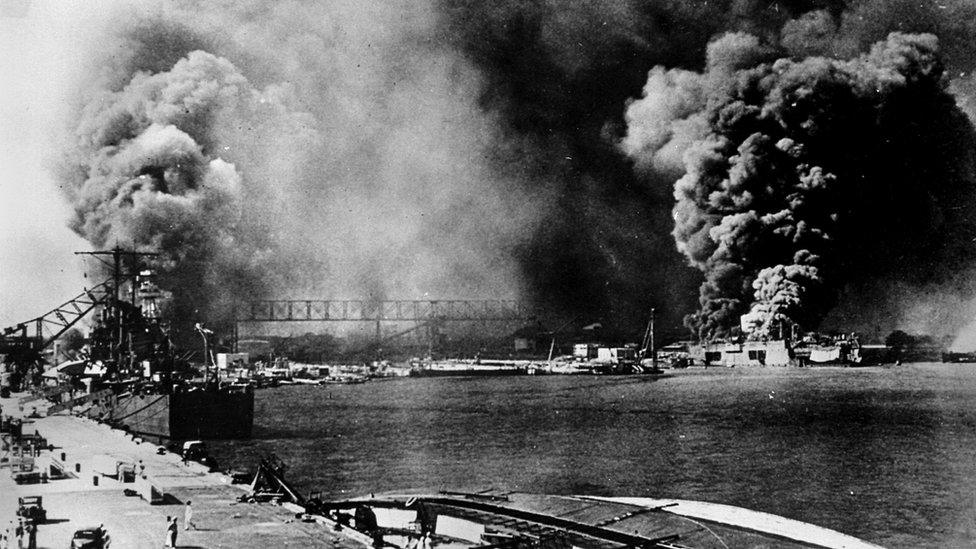
In December 1941, the Japanese attacked Pearl Harbour, which led to the US joining World War Two
In two separate meetings in 1943 and 1945, the leaders of Britain, the US and the USSR met to decide how they would deal with the Nazis in Europe. Winston Churchill was the UK prime minister, Franklin D Roosevelt was the US president and Joseph Stalin was premier of the USSR.
But by the time it came to putting into action what they had agreed, the leaders had changed. By the time of an important meeting in 1945 in Potsdam in Berlin, there was a new UK prime minister (Clement Atlee) and a new US president (Harry S Truman).
President Truman was more outspoken than President Roosevelt about his dislike of Stalin and communism, and Stalin didn't like how the US treated the USSR. Britain and the US did not trust that Stalin was going to allow elections to happen in areas which the USSR would control after the war - something that was agreed at an earlier meeting.
Even during the war, Stalin had plans to take over Eastern Europe. As the Soviets drove the Nazis back, they had begun to occupy large parts of Eastern Europe and they wanted to impose communism in these areas.
This was a worry for the US and Britain, but the Grand Alliance still had to work together to defeat the Japanese.
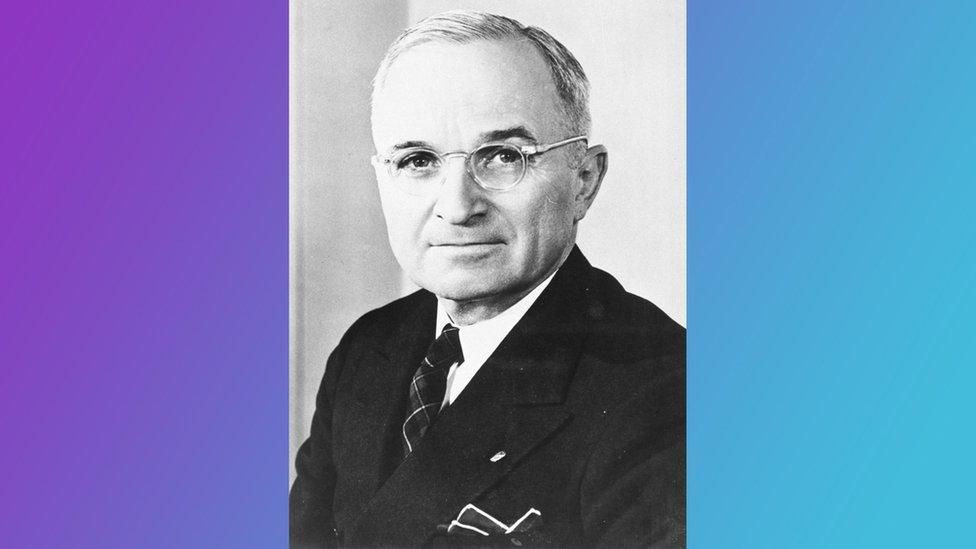
US President Truman (pictured here) was more vocal than Roosevelt about his dislike of Stalin and communism
In 1945, the US dropped two atomic bombs on Japan - one on Hiroshima and another, three days later, on Nagasaki. Around 214,000 people lost their lives.
While the Japanese surrendered from the war a few days later, some have said that dropping the bombs like this was also a way for the US to show the Soviet Union how powerful it was and who was really in control.
Shortly after, World War Two was over - but relations between the Grand Alliance had become tense and the Cold War had begun.
Cold War begins
After World War Two was fought to ensure people's freedoms, the Western allies became worried that in many parts of Europe, Nazi dictatorship was simply being replaced by communist dictatorships.
In 1946, Churchill - who was UK prime minister again - declared that an "iron curtain" had come down across Europe, as it was divided up between the east and the west. This became known as the famous iron curtain speech.
Between 1945 and 1948, the Soviets made Albania, Bulgaria, East Germany, Romania, Poland, Hungary and Czechoslovakia communist nations. This gave them a buffer zone to protect the USSR from any potential future invasions by the west.
Greece looked like it was the next country in Eastern Europe to become communist. Britain didn't have the money to stop it from happening and the west became worried about how communism was spreading.
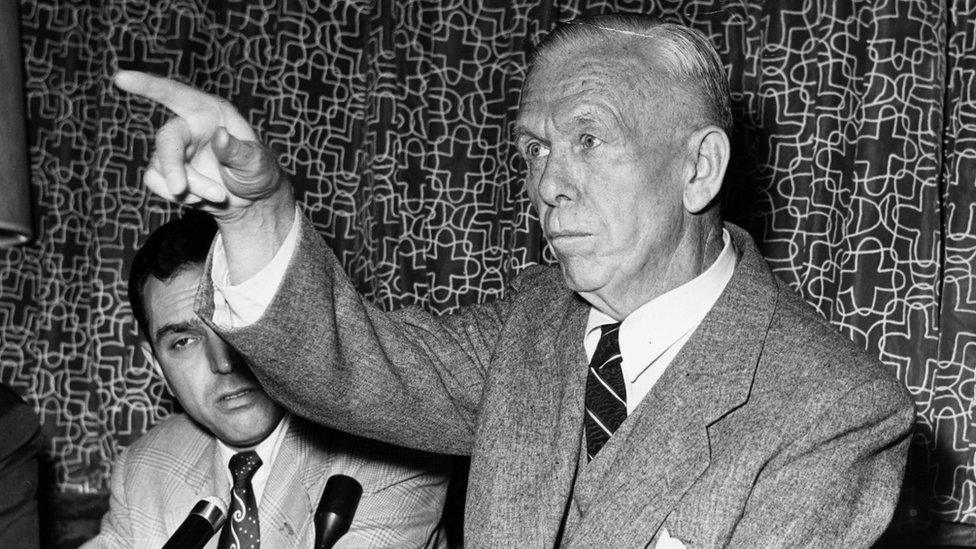
General George Marshall came up with a plan that might help to stop the spread of communism in Eastern Europe
In March 1947, the US vowed to help to stop this from happening. President Truman made a speech in which he promised that the US would help any country that took a stand against communism. It was called the Truman Doctrine. In June that year, he sent General George Marshall to see what could be done. Marshall came up with a plan - Marshall Aid - that would offer European countries money to recover after World War Two and reject communism.
In 1947, Stalin had set up Cominform - an alliance of communist countries - and he forbade any of them from applying for Marshall Aid. Then, in January 1949, the Soviets set up a council called Comecon to run its very own Molotov Plan of financial help to try to keep the communist nations on its side. In a way, both sides were trying to buy support from countries.
Why was Berlin so important in the Cold War?
Berlin would become a significant city in the conflict between the West and the Soviets.
After World War Two, Germany had been divided up into four between the US, Britain, France and Russia. Berlin was also divided in half, even though the west's portion of Berlin was surrounded by Soviet areas. It was the last gap in the USSR's buffer zone - and Stalin wanted control of it.
The Allies used money from Marshall Aid to help Germany to recover after the war. But the areas controlled by the USSR were poor and it made communism look bad. Stalin set out to take over Berlin.
In June 1948, Britain, France and the US joined their areas of Germany together in what would become known as West Germany, with West Berlin as its capital. Between 1949 and 1961 an estimated 2.7 million East Germans left for West Germany in the hope of a better life.
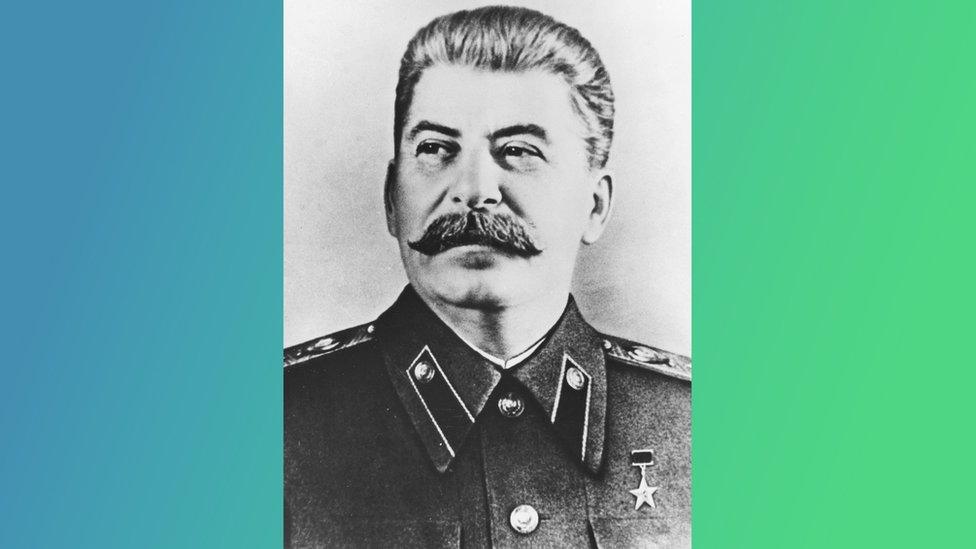
Joseph Stalin wanted to take control of Berlin
Stalin did not like any of this. On 23 June 1948, he cut the west's road and rail access to West Berlin, in what became known as the Berlin Blockade.
This meant West Berlin could only be accessed by the air. For 11 months, something called the Berlin Airlift supplied West Berlin with food and supplies from the air, as the west didn't want to force their way through by land and risk starting another war.
The blockade was lifted in May 1949, but the conflict between East and West Germany was more strongly established than ever.
The Cold War intensifies
In 1949, Nato - the North Atlantic Treaty Organisation, which was a group of countries working together to defend themselves - was formed as a result of the Berlin Blockade. It included the US, UK, Canada, West Germany, Portugal, France, Belgium, Holland, Denmark, Iceland, Italy and Luxembourg. The USSR was not invited to join the group.
In 1953, Stalin died and Nikita Khruschev became leader of the Soviets. He spoke about wanting to improve relations with the west and bring more peace, but this did not happen. In fact, 1953 to 1960 was one of the tensest periods of the Cold War.
In May 1955, Khruschev set up a military group of communist countries called the Warsaw Pact, in response to the formation of Nato. It included the USSR, Poland, Hungary, Czechoslovakia, Bulgaria, Romania, East Germany and Albania. Western countries were not part of it. This only made the feeling of east versus west even stronger.
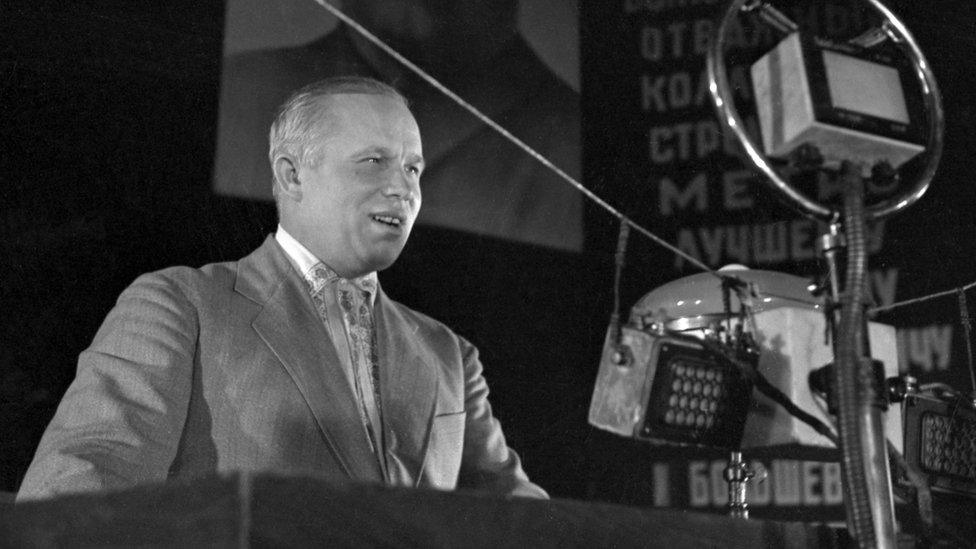
Nikita Khruschev took over as leader of the USSR when Stalin died in 1953
The world was now very much divided between two opposing sides who had different ideas.
While these groups weren't necessarily fighting against each other directly in physical battles, if any opposing countries got into a disagreement about something, the threat that this could escalate into something much bigger became very real.
The two sides also got involved in other conflicts like the Korean War in (1950-1953) and the Vietnam War (1955-1975) on opposing sides, which heightened the division between them.
By the early 1960s though, the situation in Berlin had become embarrassing for the Soviets. Nearly 2,000 refugees were escaping from the east and fleeing to the west every single day. Khruschev needed to take action to assert the USSR's power.
When the west refused to leave its zone in West Berlin, on 13 August 1961 Khruschev closed the border between East and West Berlin - and the Berlin Wall was built.
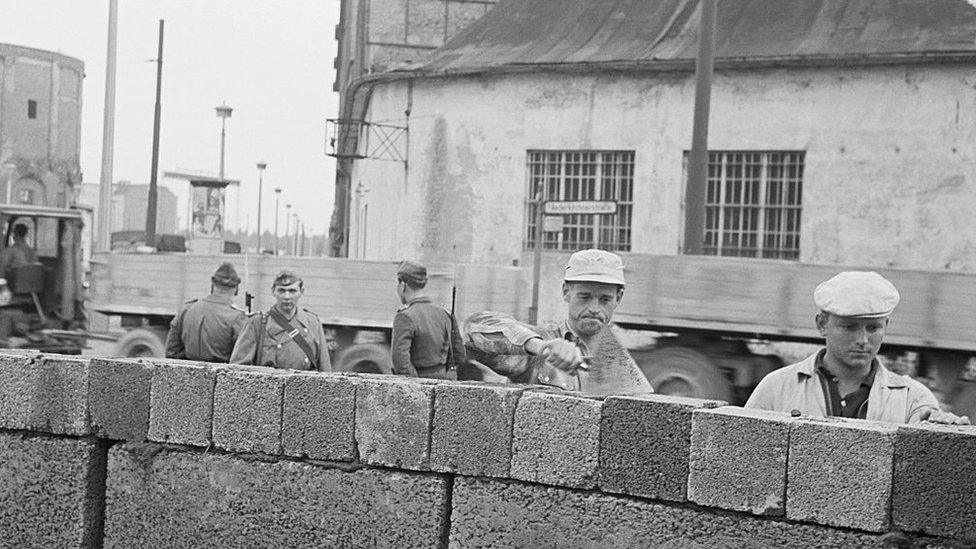
This picture shows East German workers building the Berlin wall in 1961, while being watched by communist police
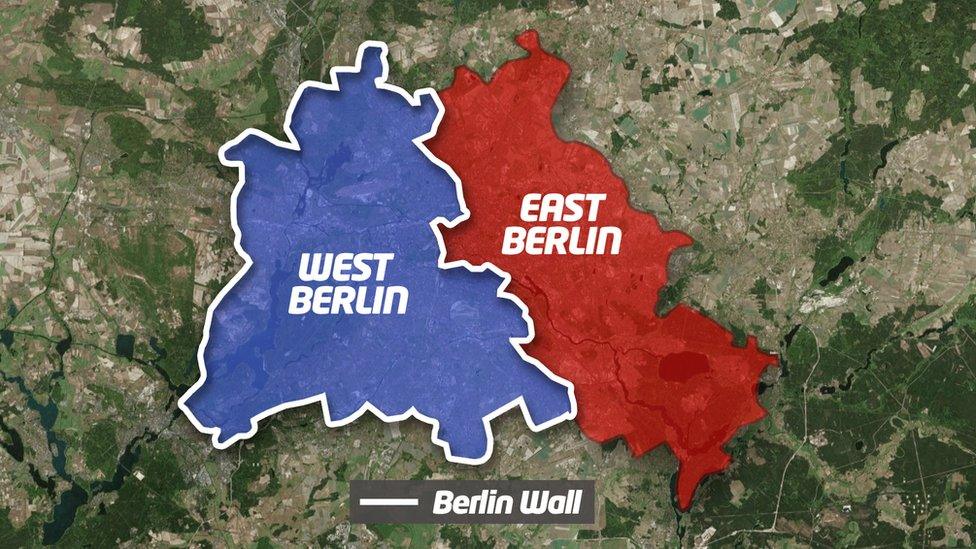
This map shows how the Berlin Wall was built around the outside of West Berlin
This became more than just a barrier dividing Berlin though. It became one of the most famous symbols of the Cold War division.
On 26 June 1963, US President Kennedy went to Berlin and gave a speech in which he said that Berlin was a symbol of freedom and the fight against communism. His strong position showed the Soviets that the west had no intention of leaving Berlin. It is often called the 'Ich bin ein Berliner' ('I am a Berliner') speech, as he showed solidarity with the people there.
The space race and the arms race were also heightening tensions.
What was the space race?
The space race was a competition between the east and the west during the Cold War for who could dominate space exploration.
In 1957, the Soviets launched the first satellite Sputnik to orbit around the Earth. Four years later, they sent the first man into space.
What was the space race? (October 2017)
The US responded by sending their own man into space and pledging to become the first nation to put a man on the Moon by the end of the 1960s. They achieved this in 1969.
What was the arms race?
During the Cold War, the west and east competed for who could build the best missiles and bombs. This was known as the arms race.
Ever since the US dropped the atomic bomb on Hiroshima in 1945, the USSR wanted to have its own similar weapon.
On 29 August 1949, the Soviets set off their first nuclear bomb.
But one of the tensest moments of the whole Cold War came in 1962, with the Cuban missile crisis.
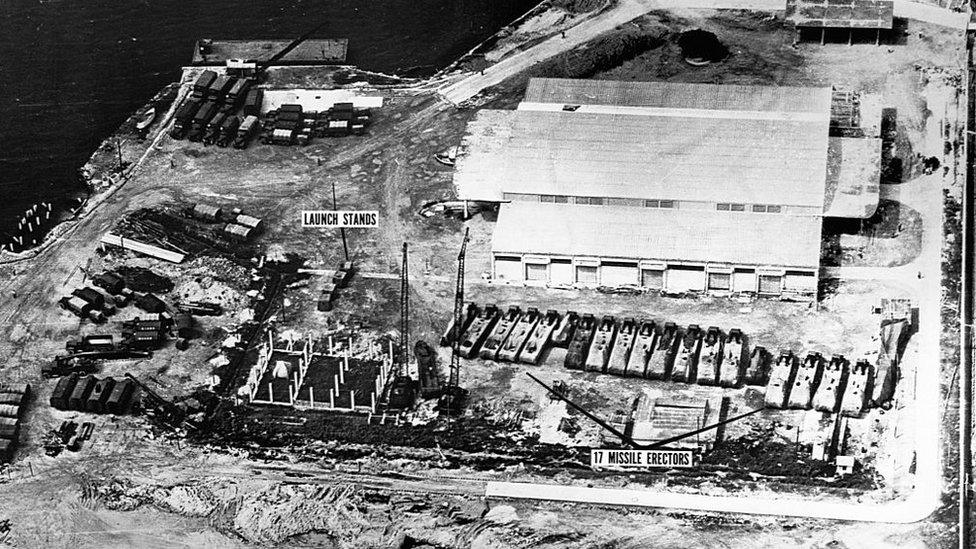
This intelligence photograph shows missile stands lined up in Cuba during the Cuban Missile Crisis
For 13 days in October 1962, the world stood on the brink of nuclear war when the Soviet Union provided communist Cuba with missiles that they could use against the US, who wanted to invade Cuba and remove its leaders (the Castros) from power.
The situation was eventually defused. Some say that it paved the way for sides to work together on agreements later in the Cold War about the development of weapons.
The Cold War was a series of events where anything the west did, the USSR would respond by doing the same.
In politics, Truman's Doctrine in 1947 was met by the USSR's Cominform.
In economics, the Marshall Plan was followed by Stalin's Comecon in 1949.
In terms of defence, the USSR responded to the formation of Nato in 1949 with its own Warsaw Pact in 1955 between the eastern European communist countries.
The atomic bombs dropped on Japan in 1945 established the US as a superpower in terms of the weapons it had. But four years later, the Soviets set off their very own nuclear bomb.
How did the Cold War end?
There were several factors that led to the end of the Cold War.
During the 1970s, tensions between the west and east relaxed a little during a period called detente.
Agreements were signed to encourage more peaceful relations, and Soviet and US crafts even docked together in space. The US allowed China - a communist nation - to join the United Nations and, in 1972, US President Richard Nixon even visited China.
But these turned out to be little more than attempts to make the world think that everyone was getting along. Neither side stuck to their end of the agreements they'd made and their involvement in wars in Afghanistan, Nicaragua and Angola in the late 1970s showed the divisions were still very much there.
But some countries were getting fed up about how much control the Soviets had over their lives. This had resulted in uprisings, which the USSR crushed, but it showed a weakening of the Soviet's communist ideas in Eastern Europe.
The arrival of two leaders in the 1980s changed everything - US President Ronald Reagan in 1980 and USSR premier Mikhail Gorbachev in 1985.

The arrival of these two leaders - US President Ronald Reagan in 1980 and USSR premier Mikhail Gorbachev in 1985 - changed the course of the Cold War
Reagan was chosen partly because he was critical of the Soviet Union and strongly anti-communism. In a speech in 1983, he called the USSR an "evil empire". He increased US spending on the military and worked closely with UK Prime Minister Margaret Thatcher to exert pressure on the Soviet Union, to the point that it had no choice but to back down.
Gorbachev, meanwhile, realised he couldn't match what the US was spending on weapons, so started talks to limit the production of nuclear weapons on both sides. If Russia was going to be a strong, global superpower, he knew it would have to make up with the west. He also introduced more popular policies promoting more freedom of speech and restructured the economy.
By the 1980s, the west and the USSR were learning how to live alongside each other more, but there was still unrest in Eastern European countries where people were poor and wanting to flee from the east. By the end of 1980s, the increased freedom and openness that Gorbachev had promoted in the USSR began to spread across Eastern Europe.
The Berlin Wall had come to be a symbol of oppression and everything that was wrong with Soviet rule. On 8 November 1989, the Berlin Wall came down and the border was opened.
You can watch Newsround's special programme to mark 25 years since the Berlin Wall came down here.
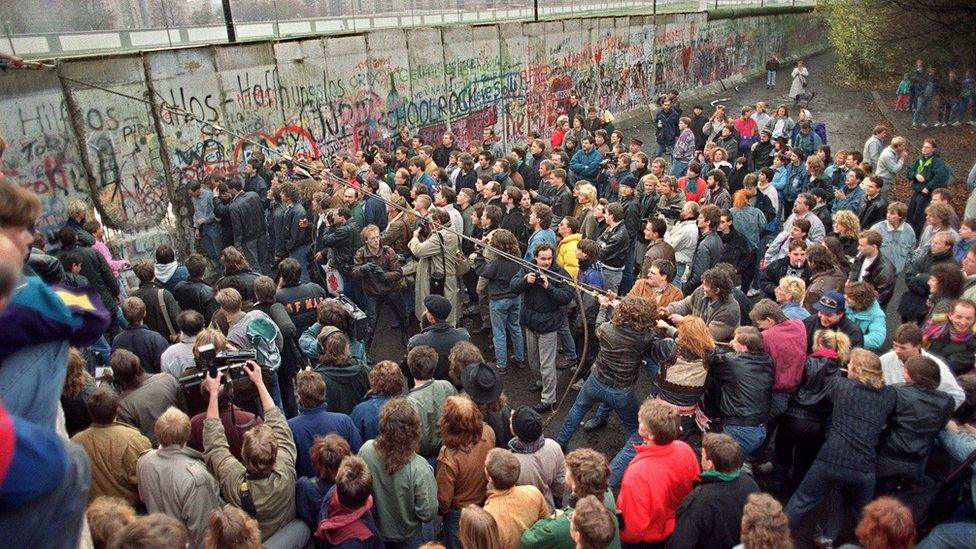
There were great celebrations as the Berlin Wall was torn down in 1989
Due to economic problems, unrest in Eastern Europe and USSR defeat in Afghanistan, in December 1991, communism in the USSR - and the Cold War - came to an end.
Russia declared itself a republic and elected a man called Boris Yeltsin as its president.
What is the situation today?
Even though the Cold War has come to an end, tensions between Russia and the west still make headlines today.
In February 2019, the US and Russia suspended their involvement in a treaty, which both nations signed back in 1987, towards the end of the Cold War.
The treaty - called the Intermediate-Range Nuclear Forces Treaty - banned both nations from using short and medium-range missiles (except sea-launched weapons).
By 1991 - when the Cold War came to an end - nearly 2,700 missiles had been destroyed.
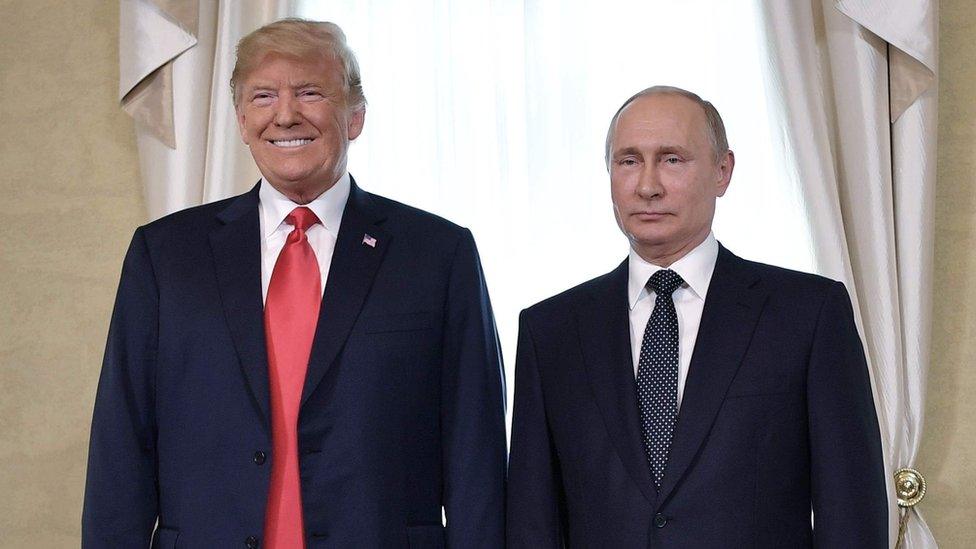
In February 2019, US President Donald Trump and Russian President Vladimir Putin said their countries are suspending their involvement in an agreement that both of their countries signed in 1987 towards the end of the Cold War
But on 1 February, the US said it would withdraw from what was agreed in the treaty and Russian President Vladimir Putin said that Russia would start developing new missiles too.
While this Cold War has come to an end, nations in the east and west don't always agree with each other.
But Malcolm Craig - a senior lecturer in US history at Liverpool John Moores University - explains: "Russia is not the Soviet Union and its international position is quite, quite different. It is much more tightly integrated into the global economic system than the USSR was."
- Published8 November 2017
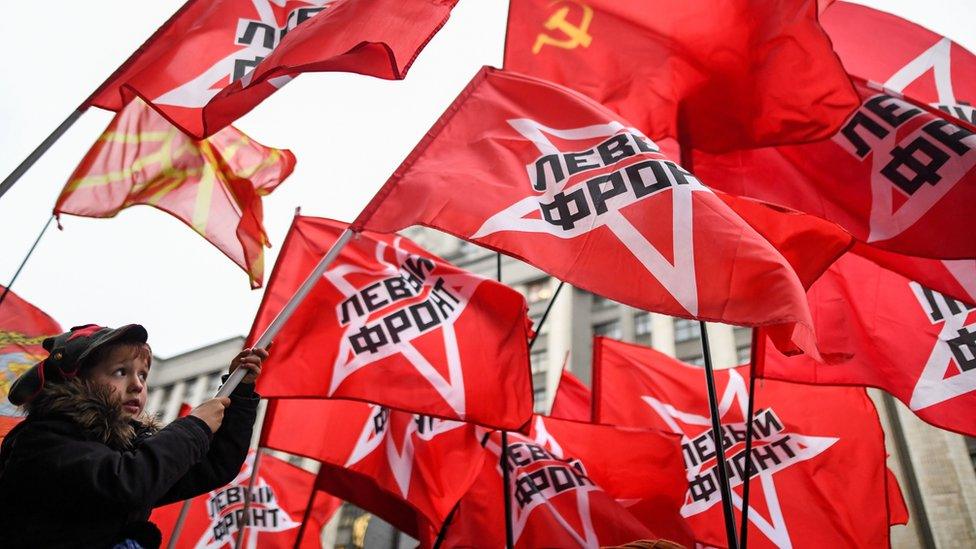
- Published6 November 2023
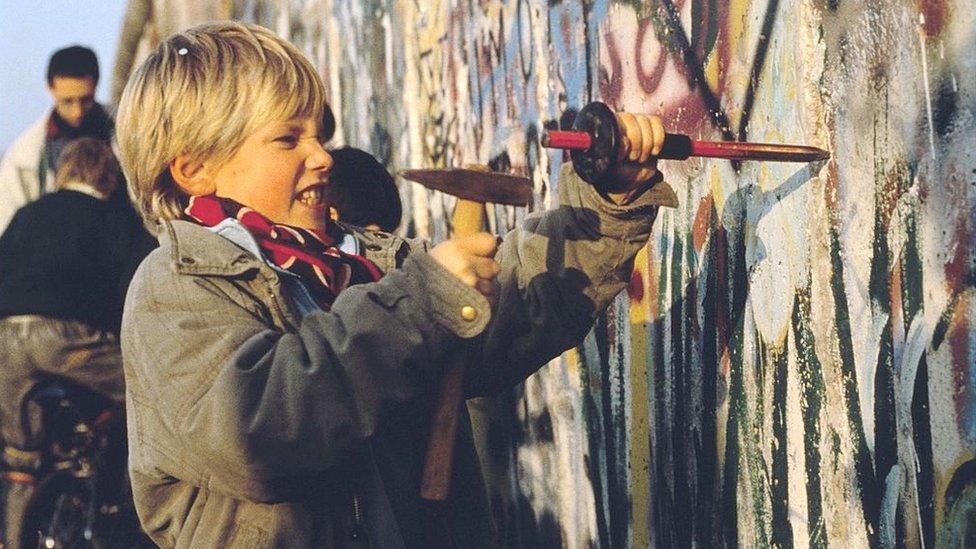
- Published10 November 2014
